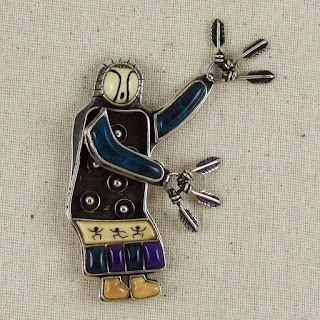In Part 2, we looked at silversmiths who could be classed as innovators, people who pushed the limits of what Indian jewelry could be. Now, in Part 3, we will look at those artists who we call the "uniques", people whose work is so unique as to defy convention. These are people who have done things in a completely new way, and have redefined what is acceptable in Indian jewelry. They could also be classed as innovators, but their work is so unique that to call them merely innovators did not seem like a strong enough term. So, we have given them their own class, because their work is truly in a class by itself. Again, those who are no longer with us are marked with a *.
Michael Kabotie*, Hopi--though he always considered himself a painter first and foremost, his jewelry, especially his triple overlay work, was absolutely unique and gorgeous. He took traditional Hopi motifs and gave them his own personal spin to create intricate and beautiful designs in both gold and silver, and took overlay work in a completely new direction. Like many of the artists in this class, his work is instantly recognizable, even from a distance.
Raymond Yazzie, Navajo--the younger brother of Lee Yazzie, and the creator of some of the most fantastically detailed jewelry made anywhere by anyone. His use of very small pieces of stone as inlay accents to larger stones is something done by no one before he came along, and he combines it with very clean and precise filework in his silver and gold.
Charles Supplee, Hopi--there is no "typical" piece by him. The variety of his work is amazing, and the quality of his materials is always top-notch. It is sometimes difficult to tell a Charles Supplee piece, because his work comes in so many different flavors.
Don Supplee, Hopi--the only jeweler who can match Charles Supplee's variety is his brother, Don. Again, his work is unconstrained by one particular style, but is always expertly made with the highest quality materials.
Harvey Begay*, Navajo--the son of the great Kenneth Begay, and as innovative and skilled as his father. Begay started out doing clean silver pieces, much like his father, but soon expanded his horizons to include casting, gold and even diamonds.
James Little, Navajo--one of the few Indian smiths who can rival Begay's work with diamonds, but also a master of more traditional materials and forms.
Denise Wallace, Chugach Aleut--we're cheating a little bit here, because she is not Southwest Indian, but her talent and creativity is amazing. She made incredible pieces with her husband Samuel, and after his death she continued to be fabulously creative, sometimes in collaboration with her daughter Dawn.
Maria Samora, Taos--one of the most exciting young talents in the field. Her work straddles the line between Indian jewelry and fine jewelry, with oxidation one of her favorite techniques.
Jesse Monongye, Navajo--the master of his own type of inlay, often imitated but never equaled. When you see an opal moon in a lapis sky, it is more than likely you are looking at one of his pieces.
Raymond Sequaptewa, Hopi--one of the artists for whom there really is no precedent. His use of found materials and his sense of design is completely unique in the Southwest, and perhaps even the world.
So, who did we leave out? There are dozens of great Indian jewelers working today, so if you have a particular favorite who was not mentioned in these blog posts, we would love to hear about it! Give us a call, or drop us an email.
Saturday, March 28, 2020
Subscribe to:
Post Comments (Atom)










Boyd Tsosie might be included inn #3? Earl Plumber in #2?
ReplyDeleteThought about those--good suggestions.
DeleteSteve, these are some of your best blogs yet. Thank you so much. Your willingness to give of your knowledge and expertise is greatly appreciated.
ReplyDeleteThank you very much.
Delete